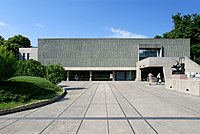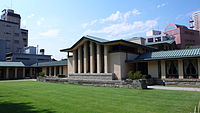List of Important Cultural Properties of Japan (Shōwa period: structures)
Appearance
This list is of Important Cultural Properties of Japan dating from the Shōwa period (1926–1989) that are structures. As of 20 February 2012, thirty-seven structures or groups thereof have been so designated. One designation may contain more than one element.[1]
Structures
| Site | Date | Location | Comments | Image |
|---|---|---|---|---|
| Kon family residence (金家住宅, Konge jūtaku)[2] | 1925 | Kita-Akita, Akita Prefecture | designation includes four elements: western-style residence, Japanese-style residence, rice storehouse, warehouse; one of the few hybrid residences in Tōhoku | |
| Marunuma dam (丸沼堰堤, Marunuma entei)[3] | 1931 | Katashina, Gunma Prefecture | 88.2 m wide, 32.1 m high; for hydroelectric power | 
|
| Former Tokyo Science Museum: main building (旧東京科学博物館本館, kyū-Tōkyō kagaku hakubutsukan honkan)[4] | 1931 | Ueno Park, Tokyo | part of the rebuilding after the Great Kantō earthquake; now the National Museum of Nature and Science | 
|
| Former Tokyo Imperial Museum: main building (旧東京科学博物館本館, kyū-Tōkyō teishitsu hakubutsukan honkan)[5][6] | 1937 | Ueno Park, Tokyo | constructed after the Great Kantō earthquake at a cost of six million yen after the design by Watanabe Hitoshi; now the Tokyo National Museum | 
|
| National Museum of Western Art: main building (国立西洋美術館本館, Kokuritsu seiyō bijutsukan honkan)[7][8] | 1959 | Ueno Park, Tokyo | by Le Corbusier; submitted in 2007 for inscription on the UNESCO World Heritage List; not a National Treasure | 
|
| Mitsui main building (三井本館, Mitsui honkan)[9][10][11] | 1929 | Nihonbashi, Tokyo | built to replace the 1889 headquarters, heavily damaged in the Great Kantō earthquake; now houses the Mitsui Memorial Museum | 
|
| Jiyu Gakuen House of Tomorrow (自由学園明日館, Jiyū Gakuen myōnichikan)[12] | 1921 | Toshima, Tokyo | by Frank Lloyd Wright; formerly the Jiyu Gakuen Girls' School; designation includes four elements | 
|
| Kachidoki Bridge (勝鬨橋, Kachidoki bashi])[13] | 1940 | Chūō, Tokyo | movable bridge | 
|
| Kiyosu Bridge (清洲橋, Kiyosu bashi])[14] | 1928 | Chūō, Tokyo | suspension bridge reconstructed after the Great Kantō earthquake | 
|
| Waseda University Ōkuma auditorium (早稲田大学大隈記念講堂, Waseda daigaku ōkuma kinenkōdō)[15] | 1927 | Shinjuku, Tokyo | named after the founder, Ōkuma Shigenobu | 
|
| Meiji Life Insurance Mutual headquarters: main building (明治生命保険相互会社本社本館, Meiji seimei hokensō gogaisha honsha honkan)[16] | 1934 | Chiyoda, Tokyo | now the headquarters of Meiji Yasuda Life Insurance Company | 
|
| Takashimaya Tokyo store (髙島屋東京店, Takashimaya Tōkyō-ten])[17] | 1933 | Nihonbashi, Tokyo | occupies an entire city block | 
|
| Bandai Bridge (萬代橋, Bandai bashi)[18] | 1929 | Niigata, Niigata Prefecture | 306.9 m long, 22 m wide | 
|
| Shiraiwa check dam facility (白岩堰堤砂防施設, Shiraiwa entei sabō shisetsu)[19] | 1939 | Toyama, Toyama Prefecture | check dam to reduce erosion and flooding; designation includes four elements | 
|
| Fugan canal lock facility (Nakajima lock gate) (富岩運河水閘施設 (中島閘門), Fugan unga suikō shisetsu (Nakajima kōmon))[20] | 1934 | Toyama, Toyama Prefecture | lock; designation includes five elements | 
|
| Katakurakan (片倉館)[21] | 1928 | Suwa, Nagano Prefecture | western-style spa complex; designation includes three elements | 
|
| Atami Hyūga Villa annex (旧日向家熱海別邸地下室, kyū-Hyūgake Atami betteichika shitsu)[22] | 1936 | Atami, Shizuoka Prefecture | by Bruno Taut | |
| Nagoya Higashiyama Botanical Garden greenhouse (名古屋市東山植物園温室前館, Nagoya-shi Higashiyama shokubutsukan)[23] | 1936 | Nagoya, Aichi Prefecture | one of the first iron and glass buildings in the country | 
|
| Hinjitsukan great hall (旧賓日館 大広間棟, kyū-Hinjitsukan ōhiroma tō)[24] | 1935 | Ise, Mie Prefecture | extension of 1887 guesthouse for visitors to Ise Jingu | |
| Haiseiden (俳聖殿)[25] | 1942 | Iga, Mie Prefecture | by Itō Chūta (伊東忠太) for the 300th anniversary celebrations of Matsuo Bashō; in the grounds of Iga Ueno Castle | 
|
| Suehiro Bridge (末広橋梁, Suehiro kyōryō)[26][27] | 1942 | Yokkaichi, Mie Prefecture | bascule bridge; former Yokkaichi Port Station railway bridge | 
|
| Nomura Hekiunsō (野村碧雲荘)[28][29] | 1927 | Sakyō-ku, Kyoto | villa built for Tokushichi Nomura II in the grounds of Nanzen-ji; the gardens use water from Lake Biwa Canal; designation with seventeen elements, including a Noh stage and chashitsu | |
| Ōe Bridge and Yodoya Bridge (大江橋及び淀屋橋, Ōe bashi oyobi Yodoya bashi)[30] | 1935 | Kita-ku, Osaka | over the Kyū-Yodo River via Nakanoshima; Yodoya Bridge illustrated | 
|
| Mengyō Kaikan (綿業会館)[31] | 1931 | Chūō-ku, Osaka | for leaders of the textile industry | 
|
| Mitani waterworks facilities: water measurement chamber (旧美歎水源地水道施設 量水器室, kyū-Mitani suigenchi suidō shisetsu - ryōsuiki shitsu)[32] | 1926-88 | Tottori, Tottori Prefecture | Shōwa additions to Meiji and Taishō waterworks; designation with ten elements, one dating to the Shōwa period | |
| Ishitani residence (石谷家住宅, Ishitanike jūtaku)[33] | 1928 | Chizu, Tottori | designation with eight elements, three dating to the Shōwa period | 
|
| Hiroshima Peace Memorial Museum (広島平和記念資料館, Hiroshima heiwa kinen shiryōkan)[34] | 1955 | Hiroshima Peace Memorial Park, Hiroshima | by Kenzo Tange | 
|
| Hiroshima World Peace Memorial Cathedral (世界平和記念聖堂, Sekai heiwa kinen seidō)[35] | 1954 | Hiroshima, Hiroshima Prefecture | by Tōgo Murano | 
|
| Watanabe Memorial Hall, Ube (宇部市渡辺翁記念会館, Ube-shi Watanabe ō kinenkan)[36] | 1937 | Ube, Yamaguchi Prefecture | by Tōgo Murano; for industrialist Watanabe Sukesaku (渡辺祐策) | 
|
| Mikawa House (三河家住宅, Mikawake jūtaku]])[37] | 1928 | Tokushima, Tokushima Prefecture | illustrates the proliferation of modern materials and styles | 
|
| Hōnen'ike Dam (豊稔池堰堤, Hōnen-ike entei)[38] | 1929 | Kan'onji, Kagawa Prefecture | 145.5 m wide, 30.4 m high | 
|
| Yanase forest railway facilities (旧魚梁瀬森林鉄道施設, kyū-Yanase shinrin tetsudō shisetsu)[39] | to 1942 | Kōchi Prefecture | construction initiated by the Ministry of Agriculture and Commerce in 1911, continuing until 1942; designation with fourteen elements, five Taishō period tunnels and nine bridges of the Showa period | |
| Shime shaft mine intake (旧志免鉱業所竪坑櫓, kyū-Shime kōgyōsho tatekō yagura)[40] | 1943 | Shime, Fukuoka Prefecture | for shaft mining in the Kasuya coal fields (糟屋炭田); 47.6 m | 
|
| Chikugo River Lift Bridge (旧筑後川橋梁 (筑後川昇開橋), kyū Chikugogawa kyōryō (Chikugogawa shōkaikyō))[41] | 1935 | Ōkawa, Fukuoka Prefecture | Vertical-lift bridge; 507.2 m | 
|
| Nabeshima residence (旧鍋島家住宅, kyū-Nabeshima jūtaku)[42] | 1930 | Unzen, Nagasaki Prefecture | designation with five elements dating from the Edo, Meiji and Shōwa periods (one element, the main building) | |
| Hakusui Dam facilities (白水溜池堰堤水利施設, Hakusui tame-ike entei suiri shisetsu)[43] | 1938 | Taketa, Ōita Prefecture | designation with two elements, the main dam and ancillary dam | 
|
| Tsukayama awamori production facilities (津嘉山酒造所施設, Tsukayama shuzōsho shisetsu)[44][45] | 1928 | Nago, Okinawa Prefecture | designation with two elements: the main building, which includes residential quarters; and the koji house |
See also
References
- ^ "Database of National Cultural Properties: 国宝・重要文化財 (建造物): 昭和". Agency for Cultural Affairs. Retrieved 20 February 2012.
- ^ "金家住宅 洋館". Agency for Cultural Affairs. Retrieved 20 February 2012.
- ^ "丸沼堰堤". Agency for Cultural Affairs. Retrieved 20 February 2012.
- ^ "旧東京科学博物館本館". Agency for Cultural Affairs. Retrieved 20 February 2012.
- ^ "旧東京帝室博物館本館". Agency for Cultural Affairs. Retrieved 20 February 2012.
- ^ "Construction of the new Honkan: The Museum during World War II". Tokyo National Museum. Retrieved 20 February 2012.
- ^ "国立西洋美術館本館". Agency for Cultural Affairs. Retrieved 20 February 2012.
- ^ "Main Building of the National Museum of Western Art". UNESCO. Retrieved 20 February 2012.
- ^ "三井本館". Agency for Cultural Affairs. Retrieved 20 February 2012.
- ^ Watanabe Hiroshi (2001). The Architecture of Tōkyō. Edition Axel Menges. p. 99. ISBN 3-930698-93-5.
- ^ "Mitsui Honkan (architectural drawings)" (PDF). Architectural Institute of Japan. Retrieved 20 February 2012.
- ^ "自由学園明日館". Agency for Cultural Affairs. Retrieved 20 February 2012.
- ^ "勝鬨橋". Agency for Cultural Affairs. Retrieved 20 February 2012.
- ^ "清洲橋". Agency for Cultural Affairs. Retrieved 20 February 2012.
- ^ "早稲田大学大隈記念講堂". Agency for Cultural Affairs. Retrieved 20 February 2012.
- ^ "明治生命保険相互会社本社本館". Agency for Cultural Affairs. Retrieved 20 February 2012.
- ^ "髙島屋東京店". Agency for Cultural Affairs. Retrieved 20 February 2012.
- ^ "萬代橋". Agency for Cultural Affairs. Retrieved 20 February 2012.
- ^ "白岩堰堤砂防施設 本堰堤". Agency for Cultural Affairs. Retrieved 20 February 2012.
- ^ "富岩運河水閘施設 (中島閘門) 閘門". Agency for Cultural Affairs. Retrieved 20 February 2012.
- ^ "片倉館 浴場". Agency for Cultural Affairs. Retrieved 20 February 2012.
- ^ "旧日向家熱海別邸地下室". Agency for Cultural Affairs. Retrieved 20 February 2012.
- ^ "名古屋市東山植物園温室前館". Agency for Cultural Affairs. Retrieved 20 February 2012.
- ^ "旧賓日館 大広間棟". Agency for Cultural Affairs. Retrieved 20 February 2012.
- ^ "俳聖殿". Agency for Cultural Affairs. Retrieved 20 February 2012.
- ^ "末広橋梁 (旧四日市港駅鉄道橋)". Agency for Cultural Affairs. Retrieved 20 February 2012.
- ^ "末広橋梁(旧四日市港駅鉄道橋)". Mie Prefecture. Retrieved 20 February 2012.
- ^ "野村碧雲荘 花泛亭". Agency for Cultural Affairs. Retrieved 20 February 2012.
- ^ "Hekiunsō". Hekiunsō. Retrieved 20 February 2012.
- ^ "大江橋及び淀屋橋 大江橋". Agency for Cultural Affairs. Retrieved 20 February 2012.
- ^ "綿業会館". Agency for Cultural Affairs. Retrieved 20 February 2012.
- ^ "旧美歎水源地水道施設". Agency for Cultural Affairs. Retrieved 20 February 2012.
- ^ "石谷家住宅". Agency for Cultural Affairs. Retrieved 20 February 2012.
- ^ "広島平和記念資料館". Agency for Cultural Affairs. Retrieved 20 February 2012.
- ^ "世界平和記念聖堂". Agency for Cultural Affairs. Retrieved 20 February 2012.
- ^ "宇部市渡辺翁記念会館". Agency for Cultural Affairs. Retrieved 20 February 2012.
- ^ "三河家住宅". Agency for Cultural Affairs. Retrieved 20 February 2012.
- ^ "豊稔池堰堤". Agency for Cultural Affairs. Retrieved 20 February 2012.
- ^ "旧魚梁瀬森林鉄道施設 落合橋". Agency for Cultural Affairs. Retrieved 20 February 2012.
- ^ "旧志免鉱業所竪坑櫓". Agency for Cultural Affairs. Retrieved 20 February 2012.
- ^ "旧筑後川橋梁 (筑後川昇開橋)". Agency for Cultural Affairs. Retrieved 20 February 2012.
- ^ "旧鍋島家住宅 主屋". Agency for Cultural Affairs. Retrieved 20 February 2012.
- ^ "白水溜池堰堤水利施設 副堰堤". Agency for Cultural Affairs. Retrieved 20 February 2012.
- ^ "津嘉山酒造所施設". Agency for Cultural Affairs. Retrieved 20 February 2012.
- ^ "津嘉山酒造所施設". Agency for Cultural Affairs. Retrieved 20 February 2012.
